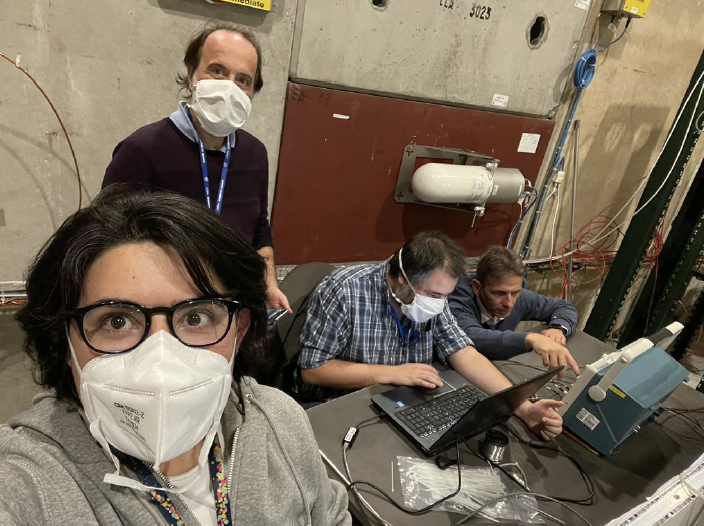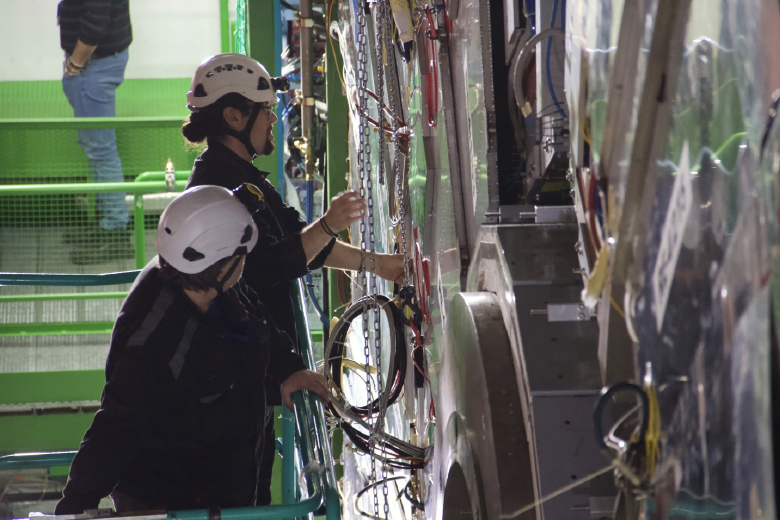
iRPC station (white ring) installed
In 2025, a new detector joined the muon detection system at the front of the CMS experiment: the improved Resistive Plate Chambers (iRPC). These detectors now occupy a complicated area with little coverage until now. In all, 72 of these new chambers will be installed to operate for the next 15 years of the LHC’s high-luminosity phase, complementing the chambers already in place (1056). They are divided into 4 stations of 18 chambers each. Two of these stations have already been successfully installed and tested in record time (3 weeks) between January and February 2025. The other two will be installed during the winter of 2025-2026.
These detectors will cover an area where muons are produced almost parallel to the LHC particle beams – at angles of between 10 and 20 degrees. These muons are accompanied by a veritable deluge of secondary particles: photons, electrons, neutrons… Despite the protections surrounding the CMS detector, many of these particles reach the detectors: up to 2,000 signals per cm2, three times more than the conventional CMS chambers can tolerate – three times more than the conventional CMS chambers can handle. That’s why the iRPCs have been specially redesigned to withstand this very noisy environment.
IP2I played a key role in this project, with over 20 people involved at various times under the leadership of Maxime Gouzevitch (scientific coordinator of the project) and Geoffrey Galbit (EDAQ technical coordinator). The institute has developed an original signal reading system, proposed by Imad Laktineh. This system is based on large, very thin electronic boards (PCBs) – 1.5 meters long by 60 cm wide, and only 600 microns thick – manufactured thanks to a partnership with the French company ELVIA, which has world-leading expertise in the field of very large PCBs. When a muon passes through the detector, it leaves an electrical signal on these plates, which is then transmitted at both ends to an ultra-fast readout board developed by the EDAQ group in collaboration with the IN2P3 OMEGA laboratory. This card, designed in large part by Claude Girerd, analyzes the signal and measures the precise moment it arrived, with CMS record precision: just 0.5 nanoseconds! And of course, all the electronics are designed to withstand radiation.


The IP2I team at the coalface.
Left: beam testing. Right: iRPC chamber installation.
Members of the institute played a leading role at every stage of the project: design, proof of concept, beam certification of prototypes, production and installation. In all, IP2I oversaw the manufacture of 160 PCBs and 160 reader boards, which it carefully tested before sending them to the assembly areas.
1) Main IP2I participants in the iRPC project:
CMS Physicists: Maxime Gouzevitch, Imad Laktineh, Laurent Mirabito, Gerald Grenier, Pierre Depasse
CMS post-docs: Ece Asilar, Jie Xiao
CMS PhD students: François Lagarde, Konstantin Shchablo, Elise Jourd’aujourd’hui
L3 Intern: Alice Albouy
EDAQ: Claude Girerd, Geoffrey Galbit, Loup Balleyguier, Xiushan Chen, William Tromeur, Gustave Garde, Guillaume Noel, Alban Luciol,
IT: Cristophe Combaret, Rodolphe Della Negra
2) Sources:
2.1) https://cms.cern/news/hi-lumi-irpc-muon-chambers-installed-cms-record-time
2.2) CMS iRPC FEB development and validation – Archive ouverte HAL
2.3) https://cds.cern.ch/record/2920454/files/DP2024_130.pdf
2.4) CMS iRPC RE-4/1 installation – YETS 2025 – CERN Document Server
2.5) CMS iRPC RE-3/1 installation – YETS 2025 – CERN Document Server
